Fun Facts About Owls And Owlets
Written by Manya Pandey, a first-year undergraduate student
Owls are nocturnal birds of prey – meaning that they sleep in the day and are out at night.
Written by Manya Pandey, a first-year undergraduate student
What’s a group of owls called? Read till the end to know…
Here’s all about Owls…
Did you know that there are some 200 different owl species? Owls are nocturnal birds of prey – meaning that they sleep during the day and are out at night.
In mythology…
In Hindu mythology, owls are the vehicle of the Laxmi, the goddess of wealth. However, the owl associated with Goddess Laxmi is worshipped mostly in the eastern parts of India, especially in Bengal, during Lakshmi Puja.
Also, they are considered creatures of wisdom and are mentioned in ancient Egyptian symbolic writings as well. Owls seemed to have fascinated our ancestors – some of their paintings date back to 30,000 BC and can still be found in caves of France.
About owls
Owls are broadly divided into two categories – one is the heart-shaped faces family, called Tytonidae and the other is a round face one called Strigidae. The former includes the most popular Barn Owls.

There are about 250 species of owls in the world, living on every continent except Antarctica.
Their blood-curdling hoots post-midnight have led to many superstitions. Some even believe that the owl can speak in a human voice if it’s starved or in distress. Such far-reaching superstitions have led to overkilling and endangering these birds but owls are harmless and beautiful birds.
And if you know Harry Potter, then you are already aware that owls help wizards, so let’s hop into the world of these majestic birds of prey with a list of facts about owls.
But first, let’s understand some terms
- Species– It’s a group of animals that share similar DNA or in layman’s terms species is closest to breed.
- Raptors or Birds of prey refer to hunter birds.
Top 10 facts about Owl
1. Owl’s flight is silent
When most birds flap their wings, it creates huge disturbances in the air called turbulence. This turbulence creates noise. Typically, the larger and faster a bird, the noisier its flight.
But this turbulence is virtually absent incase of owls, mostly due to fine soft comb-like bristles in their feathers. The fine velvety feathers break the air turbulence and instead create an almost inaudible whooshing sound.
Besides, owls have large wings relative to their body mass, which lets them fly unusually slowly.
2. A reversible toe that can point either forward or backward.
Owls have very interesting feet. Two of their toes are forward-facing, while the other two are backward-facing.
All the birds with such feet are called zygodactyl but owls have the unique ability to turn one of their back toes forward which helps them in walking and provides a better grip on the branches and rocky surfaces. This feature is missing in other zygodactyls.
Also, their feet are modified into talons (claws) which means their toes are drawn into sharp, pointed hooks. Talons help predatory birds to catch, hold and tear apart their prey.

3. They are best for natural pest control
Earthworms might be considered a farmer’s best friend but owls are their best assassins. A single barn owl family can eat 3000 rodents in four months period of birth.
They are the most efficient source of pest control because they eat all kinds of insects and rodents including mice. frogs, lizards, snakes, fish, etc.
Did you know that barn owls swallow their prey whole—skin, bones, and everything?!
One owl can eat 50 pounds of gophers (kind of rodents) in a year. Many farmers install owl nesting boxes to rid their land of pests like gophers and voles.
Although this natural form of pest control is safer and cheaper, it ends up killing owls due to the use of rodenticide.
4. They’re great hunters
Unlike other birds of prey that hunt in broad daylight, owls hunt in the cover of darkness. They’re sneaky and lethal. It’s not the speed that makes them deadly but their stealth.
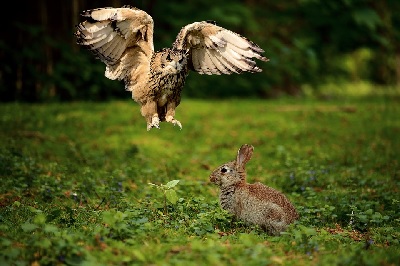
Their powerful night vision and noiseless wings make it impossible for prey to sense them out. Above all their sharp senses allow them to zero in on the location of the slightest movement
Another one of the bizarre fact about owls is that they hunt their own kind. Great Horned Owls are the top predator of the smaller Barred Owl.
5. They rarely ever make their own nest
Yes, as per this owl fact you can say they’re very lazy! They actually go house hunting and once they find a suitable hole or a deserted nest, they settle in.
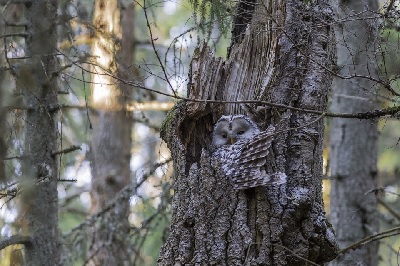
Some owls use the cavities or hollows formed in trees for housing. These cavities may be formed naturally or they could have been created via the hard work of other animals like woodpeckers
They also house inside empty buildings and cliff ledges or overhangs and some also burrow their nests.
Owls usually prefer evergreen trees like pine or spruce trees. These trees offer added protection by providing coverage throughout the year. Owl homes are passed down the generations.
6. Owls can camouflage.
The markings of various colours and patterns on an owl’s body allow them to blend into their surroundings, this ability is called camouflage. It’s an ability feathered animals have developed as a means of protection.
You might have missed an owl in broad daylight because they’re so efficient at it.
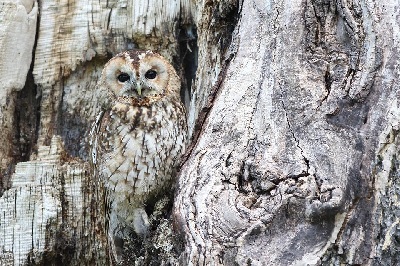
Also, owls use different kinds of camouflage, some birds rest on trees with bark that resembles their feather patterns, and some position themselves in cracks and crevices in such a way that a normal eye can’t spot them.
A snowy owl, which is white can hardly be seen in winter against the white snow.
7. Owl’s digestive juices are less acidic than other birds of prey
Owls, much like other birds, can’t chew their prey. They either straight up gobble it down and later barf out bones and indigestible parts or in case of large prey, partially tear it before swallowing
The digestion takes up to several hours but after all the nutrients have been extracted, the waste material is compressed into pellets and discarded.
Owl discards contain more residual material than other predatory birds because the digestive juices in their stomach are less acidic and also because of their habit of swallowing.
8. Some owls live in burrows
We all know rabbits live in burrows but it might be one of the most surprising facts about owls is that they live in burrows too or precisely the burrowing owls do.
The burrowing owl is a smaller species of owl that is found throughout North and South America. They nest in underground tunnels dug by ground squirrels, rabbits, chipmunks, or other burrowing animals.
Some Burrowing Owls even dig their homes themselves by using their feet and beaks.
Snowy Owls and Short-eared Owls make a shallow bowl on the ground as their nests.
Continuing the streak of owl facts, here are some Facts about Owl in India …
9. Indian Eagle Owl or Indian Owl hunts only at dusk and dawn
The owls that only hunt just before the sun comes up or just after sunset are part of the Crepuscular species. These are large, fierce, and elite raptors (birds of prey) found in the subcontinent of India Pakistan, Nepal, and Myanmar.
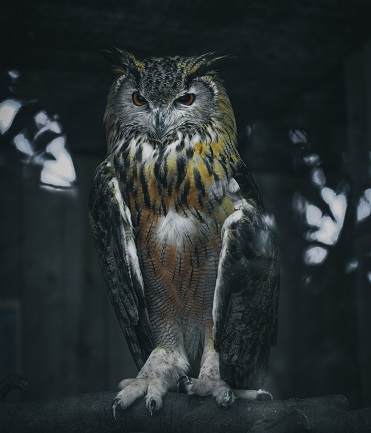
This owl has a sharp call, heard during dawn and dusk.
There are primarily two subtypes of the Indian owl- The Rock Eagle Owl is found usually in hilly terrain, and The Bengal Eagle Owl prefers hilly terrain in scrub forests.
10. The Forest Eagle-owl is known as Devil Bird
Indian forest eagle owl, generally called the spot-bellied eagle owl, is the sixth-longest owl in the world on average and it is believed to have the ninth longest wings of any living owl. You can say it’s a formidable predator.
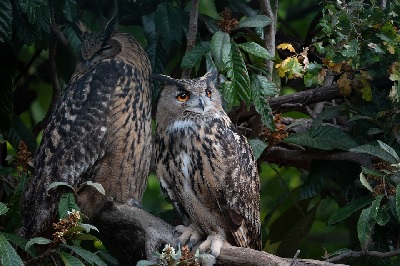
This owl hunts on peacocks, chickens, and other ground-feeding birds including rodents, and deer. They inhabit the Lower Himalayas, parts of Sri Lanka, and Vietnam.
Here’s some information about Owl ground
- Owls are found in almost all parts of the world except the freezing arctic and Antarctic regions
- Owls generally hunt close to the ground so that they can easily hear and see their prey.
- At the end of a hunting spree, owls return to their resting place, called a roost.
- Another piece of information about owl ground is that they rarely ever share a roosting area, even though it might give them an advantage against other predators and cold.
- One bit of bizarre information about owl ground is that their hunting territory is generally away from their daytime roost.
Top 5 facts about Owl eyes
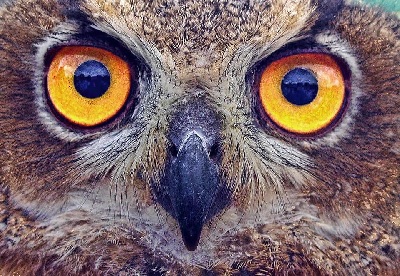
1 Owl’s eyes can’t move
The owls can not move their eyes, that’s why they have to move their entire head to look around. Owls can reportedly turn their heads to 270 degrees. Such a wide range of movement is brought about by an extra bone in their spine.
Their eyeballs are more like elongated tubes from the inside, that’s why the owls can’t move or roll their eyes, they can just look straight in one direction.
2. They have binocular vision
Binocular vision provides the ability to look at one object at the same time with different eyes, which means owls can perceive depth along with length and breadth much like humans.
Their field of view ranges up to 110 degrees but binocular vision is only 70 degrees while humans have a 180-degree view with 140 degrees binocular.
They have large eyes to increase light input in dark conditions. Better the light input, better the vision.
3. The colour of the pupils of the eyes indicates the time owls hunt.
Owls exhibit many different eye colours. Researchers believe that these eye colours evolved due to their hunting patterns.
The owls having dark eyes are more hidden from the prey at night and similarly, the owls with yellow eyes are more efficient at hunting during the day, and orange eyes developed in those hunting during the dawn and dusk.
In short, eye colour is a measure of protection.
3. Owls are far-sighted
Farsightedness is an eye condition when one can see distant objects clearly but nearby objects are blurry.
The owl can narrow down its prey from meters away, but for a nearby inspection, it needs to rely on different senses like touch and sound because everything seems blurry to an owl in close-up.
Also, the owl has fine hair-like feathers on their beaks and feet to be able to feel their food.
4. Owl sees in monochrome
There are two types of cells in the eye: light-sensitive rod cells and colour-sensitive cone cells.
Owl’s eyes have a lot of light-sensitive cells because it’s a nocturnal animal(active at night) but they have very few cone cells. So owls can see only limited colours
5. Owls have three eyelids.
The function of eyelids is to protect the eyes and while we humans have only two, owls have three of them.
They are each positioned differently. The upper eyelid helps in closing the big round eyes when the owl blinks, and the lower eyelids close upwards when the owl is asleep.
The third eyelid runs diagonally across the eye and its function is to clean and protect the eye surface. Biologically it is called a nictitating membrane and is a thin layer of tissue.
Top 5 facts about owlets
What are owlets?
Baby owls are called owlets or nestlings but in some cases, even the grown-up owls that remain small in size are referred to as owlets, namely pygmy owl and Athene African and Southeast Asian countries
1. Their birth depends on food stock
When food is plentiful, the female owls may lay one to fourteen eggs over multiple weeks. The eggs are usually round and white.
The number of eggs also depends on how much food is available. So as per this owlet fact, if enough food is available, a female short-eared owl might lay as many as ten eggs. Under limited food supply, owls may produce as low as one egg or maybe none at all.
2. Owlets hatch 3 to 5 weeks after the eggs are laid.
Depending on the species, the owl babies take up to 5 weeks to hatch. The eggs are usually laid at different times,so all of them hatch about one or two weeks apart. This is called asynchronous hatching.
The female begins incubation with the first egg, proceeding in the order they were laid. That’s an owlet fact!
3. They make noise while flying
Another owlet fact is that the babies start exploring the world outside their nest after 7-12 weeks, but their wings are not developed until much later.
So unlike the adult owls that fly noiselessly through trees and over preys, owlet wings make flapping noises.
4. Owlet’s mother loses belly feathers to keep them warm.
The eggs of all birds need to be kept warm otherwise the bird inside dies, this process is called incubation.
The female owl sits on the eggs to maintain the temperature and also loses the feathers on her belly to be able to transfer more body heat to the eggs.
She lies on the nest with her head low and stomach down, pressing her skin directly against the eggs maintaining an incubation position.
5. Owlets cry out to their parents for food.
Yes, the birds do it too, in fact, owlets are more similar to human newborns than you might imagine. They are also unable to do anything on their own when they’re born.
Owlets can’t even maintain their body temperature(Thermo regulate) on their own. So the mother broods over the nest to keep the babies warm. She only leaves to help in hunting for food after she’s assured that the babies can thermoregulate themselves.
Top 5 facts about Owl for kids
1. Sharp hearing
Owls have a very sharp hearing. They can mark a prey’s location from meters away just by using sounds. While bats use a biological SONAR technique that sends a sound wave forward and the object/ prey on the way reflects it back, owls actually have special placement of ears.
One of their ears is positioned higher, which helps them to hear sounds from multiple directions. So, unfortunately, no sneaking around for owly babies.
2. Owls sometimes hide their food.
After capturing the prey, they use their pointy beaks to stuff the food into a hiding spot. This method is called caching (pronounced CASH-ing). Some of the hiding places include the forking tree branches, in grass tufts, or underneath a rock.
Owls do this to stock up on their meat when abundant prey is available. They usually return for the prey within a day or two.
If not stored they either eat their prey whole or use their sharp talons(pointed feet in birds) to rip it into pieces.
3. Not all owls are hooters!
Just as the birds chirp, owls hoot but not all of them. Barn Owls make hissing sounds, such a sound may be used to threaten any intruder approaching the nest but among themselves, it may be a way to invite female owls to check out a nest site or for other lady jobs.
Barn owl’s choice of sound seems less weird when you consider Screech-Owls. They whine like a horse, and Saw-whet Owls are named after their sound. They sound like an old whetstone sharpening a saw for real.
4. Together they form a parliament.
Did you know that a group of owls is called a ‘parliament’?
The set phrase comes from a book, namely The Chronicles of Narnia by C.S. Lewis. In the book, he gave an interesting depiction of the meeting of talking owls who gather around at night and organise a parliament to discuss the state of affairs in the land of Narnia.
5. Asymmetrical ears
Many owl species have asymmetrical ears. Such ears are located at different heights on the owl’s head; this positioning helps the owl to catch sounds coming from all directions. This arrangement also gives it a sense of height.
Owl ears are located under feathers on the sides of their head. Their accurate hearing is what makes them the most dangerous hunters in the sky.
Now, these are more owl facts than you have read anywhere else 🙂
You May Also Like
Fun Facts About Kangaroos
Facts About Lions
Smallest Dogs in 2022

Better Your Child’s G.K. In 3 Minutes – Get This Free Newsletter
Get fun facts, simple and easy news, quizzes, and lots of other interesting things to read in your mailbox – for free! It’s what we call GK-on-the-go!
I Kid You Not now has a large readership across India and also parts of the world. If you want to write for us, you can submit your story here. You can also apply to become a news anchor. Apply here



Comments